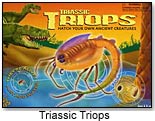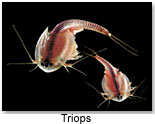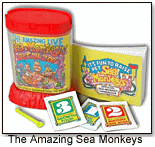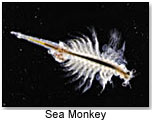
December 13, 2025


| Predators from the far reaches of the past, these guys like their food daily and will even eat one another when they have nothing better to do — which a lot of boys like to watch. |
In This Corner, the Challenger: Triops!
($4.95 to $27.95)
 “We’re the real thing, not a spoof,” expounded Dr. Eugene Hull, head of Triops Inc. “If half of a group of kids buy Triops, and the other half Sea-Monkeys, the other half will be too embarrassed to talk about their animals when they hatch. Triops are biological wonders.”
“We’re the real thing, not a spoof,” expounded Dr. Eugene Hull, head of Triops Inc. “If half of a group of kids buy Triops, and the other half Sea-Monkeys, the other half will be too embarrassed to talk about their animals when they hatch. Triops are biological wonders.”
Over twice the size of Sea-Monkeys, these branchiopods grow fast … but also die off fast. Predators from the far reaches of the past, these guys like their food daily and will even eat one another when they have nothing better to do — which a lot of boys like to watch.
Native to the scummiest water, triops had to be grown by Triops in their own lab "in order to keep contaminant-free,” said Hull. “Also, the old collection methods were raping ponds and destroying the environment. I couldn’t be a part of that.” 
Unique traits: Triops have three eyes! Triops’ market share is smaller than that of Sea-Monkeys, but they’re fighting hard with colorful packaging and a niche marketing campaign that focuses on Triops’ “prehistoric” past and scientific nature. Also, Triops are weirder looking, which makes them more boy-centric than the Sea-Monkeys. “In the end, there will be Triops, and Sea-Monkeys will be a thing of the past.”
In the Other corner, the Champion: The Amazing Live Sea-Monkeys!
($8.95 to $19.95)
 Sea-Monkeys are a household name to anyone who grew up in the ´60s and ´70s. “We are more than just the animals in their tanks, we are all things Sea-Monkeys, from artwork to slot machines. We even have a patent from the U.S. Patent Office,” expounded George C. Atamian, president of the Sea-Monkeys division at Educational Insights (ToyDirectory), parent company for the Sea-Monkeys. “We don’t even think about Triops. They’re a non-issue.”
Sea-Monkeys are a household name to anyone who grew up in the ´60s and ´70s. “We are more than just the animals in their tanks, we are all things Sea-Monkeys, from artwork to slot machines. We even have a patent from the U.S. Patent Office,” expounded George C. Atamian, president of the Sea-Monkeys division at Educational Insights (ToyDirectory), parent company for the Sea-Monkeys. “We don’t even think about Triops. They’re a non-issue.”
Peaceful crustacean cousins to Triops, Atamian sees Sea-Monkeys “as pets, not biological curiosities. That’s a big difference.”
Only needing to be fed once a week, Sea-Monkeys are fairly low-maintenance — once they’re set up. Still, they require clean water … but since their water is saltwater, it doesn’t contaminate “like Triops water can,” chimed in Atamian cheerfully. “In fact, in our 45 years on the market, there hasn’t been one lawsuit against us.” Sea-Monkeys tend to be non-gender specific, fascinating both boys and girls equally. “I don’t want to speak badly of anyone,” concluded Atamian, “but we are Sea-Monkeys. Everyone else is an imitation.”
Ding! Ding! Ding! And the winner is?
Sea-Monkeys sell in larger quantities and more globally than Triops because of their “name recognition” — they also have spin-off merchandising. Triops are hotter sellers when there’s a choice between the two and are increasingly gaining recognition, according to a TDmonthly survey of 9 retailers, and the input of both Atamian and Hull. Triops go more boy (by a small edge), but parents have grown up with Sea-Monkeys, so they’re more likely to ask for it. Both are fascinating creatures. Your own temperament may decide, or better yet: try both and let the kids choose.
For more details on grow-your-own science kits, click here. To read more about Triops, see ToyOps Excels With Toys That Teach.
Copyright © 2025 TDmonthly®, a division of TOYDIRECTORY.com®,
Inc.